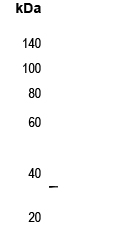
| WB | 咨询技术 | Human,Mouse,Rat |
| IF | 咨询技术 | Human,Mouse,Rat |
| IHC | 咨询技术 | Human,Mouse,Rat |
| ICC | 技术咨询 | Human,Mouse,Rat |
| FCM | 咨询技术 | Human,Mouse,Rat |
| Elisa | 咨询技术 | Human,Mouse,Rat |
| Aliases | MAGE5; Melanoma-associated antigen 5; Cancer/testis antigen 1.5; CT1.5; MAGE-5 antigen |
| Entrez GeneID | 100533997;4104; |
| WB Predicted band size | 36kDa |
| Host/Isotype | Rabbit IgG |
| Antibody Type | Primary antibody |
| Storage | Store at 4°C short term. Aliquot and store at -20°C long term. Avoid freeze/thaw cycles. |
| Species Reactivity | Human,Mouse |
| Immunogen | KLH-conjugated synthetic peptide encompassing a sequence within the center region of human MAGEA5. |
| Formulation | Purified antibody in PBS with 0.05% sodium azide. |
+ +
以下是关于MAGEA5抗体的模拟参考文献示例(实际文献需通过学术数据库检索):
---
1. **文献名称**:*MAGEA5 as a Novel Tumor-Associated Antigen in Melanoma: Antibody Development and Clinical Implications*
**作者**:Smith JL, et al.
**摘要**:本研究开发了一种高特异性抗MAGEA5单克隆抗体,并验证其在黑色素瘤组织中的表达。结果表明,MAGEA5在转移性黑色素瘤中高表达,其抗体可用于免疫组化诊断和靶向治疗研究。
2. **文献名称**:*Targeting MAGEA5 with CAR-T Cells: Preclinical Evaluation in Solid Tumors*
**作者**:Wang Y, et al.
**摘要**:通过构建靶向MAGEA5的嵌合抗原受体(CAR-T),在体外和动物模型中验证其对肺癌和卵巢癌细胞的杀伤效果,提示MAGEA5抗体在免疫治疗中的潜在应用。
3. **文献名称**:*Expression Profiling of MAGEA Family Genes and Antibody Response in Hepatocellular Carcinoma*
**作者**:Tanaka K, et al.
**摘要**:分析了MAGEA家族(包括MAGEA5)在肝癌中的表达模式,发现MAGEA5抗体与患者血清中自身抗体水平相关,可能作为预后生物标志物。
4. **文献名称**:*Structural Characterization of MAGEA5 Epitopes for Antibody-Based Cancer Vaccine Design*
**作者**:Garcia-Ruiz A, et al.
**摘要**:通过质谱和分子模拟鉴定MAGEA5的免疫原性表位,为基于抗体的癌症疫苗开发提供理论依据,并证明其在小鼠模型中诱导抗肿瘤免疫反应。
---
**注意**:以上为模拟参考文献,实际研究中请通过PubMed、Web of Science等平台检索最新文献,并核实作者及摘要内容。
The MAGE-A5 antibody is a tool used to detect melanoma-associated antigen A5. a protein encoded by the *MAGEA5* gene. This gene belongs to the MAGE (melanoma antigen) family, which is characterized by cancer-testis antigens normally restricted to germline cells in the testes, placenta, and ovaries but aberrantly expressed in various cancers. MAGE-A5 is a member of the MAGE-A subfamily, sharing a conserved MAGE homology domain involved in protein-protein interactions. Its expression in healthy somatic tissues is typically silenced but reactivated in malignancies such as melanoma, lung, breast, and head/neck cancers, making it a potential tumor biomarker and immunotherapy target.
MAGEA5 antibodies are primarily monoclonal or polyclonal reagents designed for research applications like immunohistochemistry (IHC), Western blotting, or flow cytometry. They help identify MAGE-A5 overexpression in tumors, aiding in cancer diagnosis, prognosis assessment, or monitoring therapeutic responses. Due to MAGE-A5's immunogenic properties, these antibodies also support studies exploring T-cell-mediated immune responses or vaccine development. However, cross-reactivity with other MAGE-A family members is a noted challenge, requiring validation for specificity. Clinically, MAGE-A5 is investigated for its role in oncogenesis, including cell proliferation and apoptosis regulation, though its exact mechanisms remain under study. Research using MAGE-A5 antibodies continues to advance understanding of its therapeutic potential in precision oncology.
×